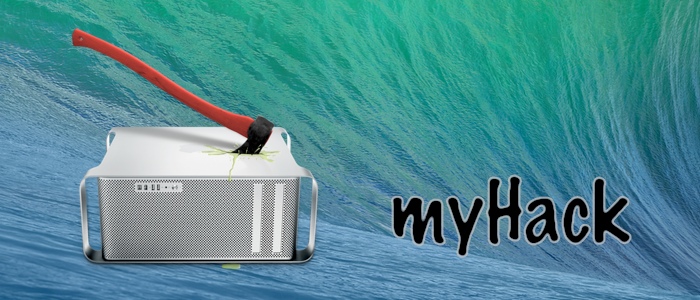 This week, Apple publicly released the newest iteration of its Mac OS X operating system, OS X 10.9 Mavericks. Fortunately, Mavericks is just as Hackintosh-compatible as all previous iterations of Mac OS X; Conti released a Mavericks-compatible version of his myHack installation tool within days of the official Apple announcement. If you're interesting in running OS X Mavericks on your PC, it's actually pretty straightforward to set up with myHack.
This week, Apple publicly released the newest iteration of its Mac OS X operating system, OS X 10.9 Mavericks. Fortunately, Mavericks is just as Hackintosh-compatible as all previous iterations of Mac OS X; Conti released a Mavericks-compatible version of his myHack installation tool within days of the official Apple announcement. If you're interesting in running OS X Mavericks on your PC, it's actually pretty straightforward to set up with myHack.LAST UPDATED ON: November 4, 2013
Requirements:
- A compatible computer: Not every computer will work with Mac OS X, even with the help of myHack. Be sure to read the Hackintosh compatibility guide very carefully, to check whether or not your computer qualifies. The hardware requirements for OS X Mavericks are essentially identical to those for OS X Mountain Lion; AMD processors and older 32-bit Intel processors (such as Pentium M) are not supported. If your computer already has OS X Mountain Lion installed, myHack will just update Mountain Lion to Mavericks normally, without deleting any of your apps or files.
- An empty hard drive partition: Mac OS X needs its own hard drive partition (a minimum of 10 GB of space is required, but at least 50 GB of space is recommended).
- myHack (Free): myHack is a Mac program that modifies the official OS X Mavericks DP1 installer, and writes it onto a USB drive. You can then use this myHack USB drive to run the Mavericks installer on a PC. myHack works with Mac OS X Snow Leopard and newer.
- A Hackintosh with Snow Leopard/Lion/Mountain Lion already installed, a real Mac, or a Mac OS X virtual machine: myHack is a Mac app, so you need a computer with Mac OS X to run it. You could use a real Mac, if you own one. As another option, you could install Mountain Lion on a virtual machine, and run Unibeast on there instead. Be sure to install the Virtualbox Extension Pack to view USB drives from your virtual machine.
- OS X 10.9 Mavericks: The method used by this guide requires that you have a copy of the Mavericks installation app, which is available for free from the Mac App Store.
- An empty USB drive (8 GB or larger): The USB drive used for myHack must be at least 8 GB in size. Since myHack will erase all of the files on your USB drive, make sure to back up its contents first. You can reuse this USB drive for normal stuff after you finish installing Mavericks.
- Multibeast (Free): Multibeast is a collection of kext files that your Hackintosh will need to run properly, after the initial installation. Download it onto a USB drive. Be sure to download the newest version 6 of Multibeast, not the older versions 3, 4, or 5.
1. Run myHack
2. Install Mavericks!
From here, the installation process is pretty much the same as the process for alternative tools like Unibeast. You can refer to Steps 3-7 of our Unibeast installation guide.
Obviously, you won't have to follow Steps 1-2 of the Mountain Lion guide, which are about running Unibeast. You've already made your own installer USB drive, with myHack! Otherwise, the installation process is mostly the same-- you'll still have to make sure that your computer and BIOS are set up (Step 3-4), and go through the normal installation and post-installation procedures (Steps 5-7).
The only other thing that's really different is that the myHack installer USB drive lets you install Hackintosh-specific kexts and configuration files straight from the OS X installer. So when you install OS X Mavericks, myHack will also prompt you to install an "Extra" folder.
- If you're installing Mavericks on a new computer, choose the "Use Generic One" option.
- If you're upgrading an existing Mac OS X installation to Mavericks, choose the second option, which lets you install your own personal "Extra" folder-- select the "Extra" folder located at the base of your main hard drive.
And that's all there is to it! Thanks to myHack, you should be able to boot OS X Mavericks from your computer's hard drive (without the help of the myHack installer USB drive) immediately after the initial installation. You can set up the rest of your Hackintosh (enable sound, ethernet, etc.) with Multibeast. Now you can check out the cool new features in Mavericks.














